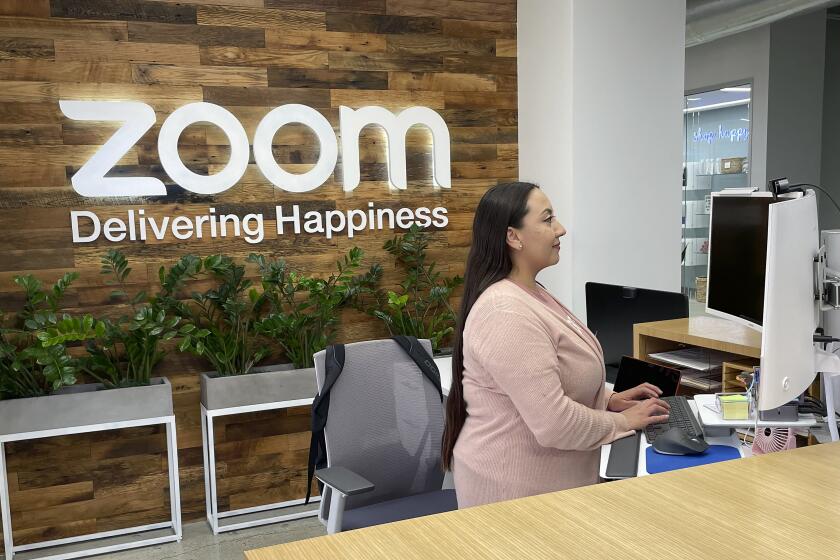
- Share via
These days, it looks like the bloom is coming off the rose for remote work: Many employers are talking tougher. New research shows employees are actually less productive when they work from home full-time. And, with the tight job market starting to slacken, some predict 2024 will be the year employers finally clamp down.
But don’t be too quick to conclude things are going back to the days of 9 to 5 in the old cubicle.
It’s true that widespread studies based on standard measures of efficiency have found that fully remote employees are 10% to 20% less productive than those working on company premises. Challenges related to communications, coordination and self-motivation may be factors in the decline.
And some employers have been warning that those who fail to meet new standards for being in the office may find adverse effects on their performance evaluations and incomes.
But the new research that showed lower productivity by full-time remote workers also found that those on a hybrid schedule — some days at home and some on site — were about as productive as those in the office full time. And there’s some evidence that companies offering greater flexibility to workers may achieve better financial results.
A surprising study shows most workers like working remotely some days but would prefer to be in the office more often than they are.
Potentially even more important than abstract data are the surprisingly deep feelings of a great many workers about holding on to at least some degree of flexibility. And those personal feelings, which involve such cut-to-the-bone issues as commuting and the cost of child care, are being reinforced by gains in communications technology and the persistent shortage of qualified workers.
Since the pandemic, John Sturr, a 58-year-old social worker for Sonoma County, has been working two to three days a week from his desk in his bedroom. On days in the office he confers with colleagues and responds to walk-ins. He’s come to love the arrangement.
“The commute is beautiful, through vineyards” along the Russian River Valley, he says, “but it’s an hour out of your day.” The time that Sturr saves he uses to put dinner on early and run errands.
“I’ve never been able to telework my whole career. Previous managers were always suspicious. This is kind of amazing.”
Productivity vs. profitability
Today, about 30% of all full-time employees are on a hybrid schedule, according to WFH Research, which monitors remote work trends by surveying thousands of workers every month. Deborah Lovich, who leads Boston Consulting Group’s work on “people strategy,” sees more employers adopting hybrid work as they see the financial and nonfinancial benefits. “I do think people will come around,” she said.
The outlook for fully remote workers, who currently make up about 10% of all employment, appears more cloudy. Those job openings have been shrinking faster in recent months as the job market has slowed.
The back-to-the-office campaign by many employers has run into resistance from workers. They’ve struck a truce of sorts — hybrid work.
Many people working full time from home are in high-paying tech and information industries, which explains why San Francisco and Los Angeles metro areas are No. 1 and 2, respectively, when it comes to the share of all full-time workdays done at home, at 46% and 40% as of November.
At the other end of the pay scale are fully remote workers in administrative and more routine functions, such as customer service representatives at call centers, where many jobs may be further eroded by artificial intelligence.
But even fully remote work has things going for it. For many employers, what may be lost in productivity can at least partly be made up in cost savings from cutting back on office and related expenses. Plus, these companies can hire workers more cheaply anywhere in the world. All told, Nicholas Bloom of Stanford University estimated that those savings may average 10% of a company’s operating costs.
“Firms shouldn’t care about productivity, they should care about profitability,” said Bloom, who is part of the WFH Research group.
Whatever the productivity studies may show, Bloom said, what’s happening is intuitive. “Look at their actions,” he said. “This is no longer a pandemic, and millions of firms in a capitalist economy are doing something consistently [in sticking with remote work]. I can only conclude it’s profitable.”
Santa Monica-based TrueCar decided to go fully remote after the pandemic. “It gives us full access to talent,” said Jill Angel, chief people officer at the firm, which operates a digital platform helping consumers shop and price cars.
TrueCar has cut back about two-thirds of its office space and eventually plans to get down to just 4,000 square feet, enough for client meetings and team-building events.
The company currently has about 325 employees across the country. And over the last three years, 48 employees have moved out of California to other states, with Texas and Washington being the most popular destinations.
Workers are happier when they have control and certainty over their work schedules, Angel said, and the firm is betting that over time that will help make it both more productive and more profitable.
“I do know we’re not going back,” she said.
Many people of color found remote work lessens the racism they face on the job. Now they must decide: Is it worth trying to never return to the office again?
Flex Index, which tracks employers’ remote-work practices, and Boston Consulting Group recently teamed up to study the finances of more than 500 public companies. Their key finding: Revenues at fully flexible firms grew on average by 21% from 2020 to 2022 — four times greater than at less-flexible firms.
Rob Sadow, a Flex Index co-founder, expects more such data to emerge highlighting differences in financial results as well as in employee retention rates. He says his company’s research shows smaller and younger firms are more likely to adopt flexible work policies, so as more businesses get started, and more office leases roll off, the share of employers offering remote work should grow.
“In early 2023, 50%-plus of companies were still sitting on the sidelines with no formal policy or specific work-from-home strategy,” he said. “What’s happened through 2023 is that more and more companies decided to put a stake in the ground — and that’s hybrid.”
Still, a lot of bosses remain wary of even partial remote work, fearing it’ll weaken their company’s culture, mentoring traditions and timely decision-making.
“We’re constantly looking at it,” a top executive at a San Diego media firm said of remote work. He didn’t want to be identified, worrying that anything he said publicly could make it harder to change work-from-home policies later. His firm currently requires everyone to come in two days a week, including one set day.
“We felt value in having everyone in the office at least one day a week because it brought younger team members to intermingle and collaborate with seasoned members,” he said.
But a lot of employees want to be 100% remote, he added. “This is one of the most sensitive subject matters I’ve dealt with.”
California’s progressive employment laws and generous state-mandated benefits are often lost when workers move to red states to find cheaper housing and lower taxes.
Teams know best
Right now, it’s pretty much anybody’s guess which of the many possible models will prevail when it comes to balancing management’s desire for an on-site workforce and employees’ desire for more flexibility.
Clearly, a lot of workers like the hybrid model but want about one day more of working from home than bosses prefer, which now averages two days a week, according to WFH Research.
At many firms, the conflict is only heightened because chief executives have dictated rules and norms for the company as a whole, said Robert Pozen, a senior lecturer at MIT Sloan School of Management who has written books on productivity.
“Let the team decide what’s best for the team,” he advised, noting that what’s functional and productive will be different if you’re in IT, customer service, sales or financial analysis.
Zoom Video Communications, a one-time darling of the work-from-home era, is calling workers back to the office.
“Bosses want accountability and they used to get it by counting hours in the office. Hopefully they realize it’s what results they get. We should be focused on what we want to achieve,” Pozen said. “Let’s figure out the goals and let’s customize the success metrics that would best measure productivity.”
That’s pretty much the playbook at Chicago-based law firm Chapman & Cutler. Sarah Andeen heads the firm’s library and research services for attorneys working in several states. The firm’s basic policy on remote work isn’t a one-size-fits-all but rather is based on the department’s and clients’ needs and expectations.
For Andeen and her two research staffers, it worked out to two to three days on site, with at least one of them in the office each workday to open the library and address any in-person requests from attorneys.
“I think it depends on the person, the work they do and stage of career,” Andeen, 54, said of how best to structure hybrid work.
From yoga classes to musical performances, landlords are trying to woo back workers who left office space vacant during the pandemic.
She said the older of her two staff librarians is in her 60s, lives in a Chicago suburb and uses the time saved from the 45-minute commute to get in a little more gardening and other personal projects. Andeen’s other librarian is in her late 20s, lives in an apartment in the city and really likes coming in three days a week to the firm’s new downtown office, designed to be more collaborative.
“I know my staff. I know they’re being productive,” Andeen said, adding that her team has clear goals and productivity measurements. “Are we getting research questions answered in a timely manner? Are the bills getting billed, the research cataloged? Is our web page up and operational? Are our attorneys happy? ... I can see the results.”
More to Read
Inside the business of entertainment
The Wide Shot brings you news, analysis and insights on everything from streaming wars to production — and what it all means for the future.
You may occasionally receive promotional content from the Los Angeles Times.

















